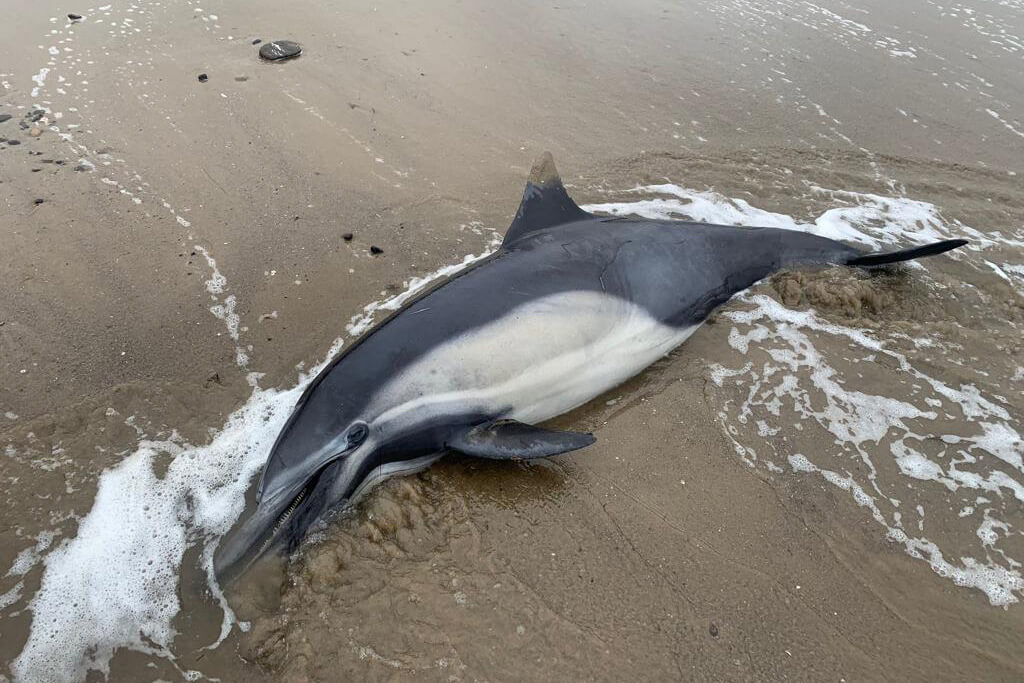Toxic Algal Bloom Suspected in Dolphin and Sea Lion Deaths in ... - NOAA Fisheries

The rapid growth of harmful algae along parts of the Southern California Coast is believed to have killed hundreds of California sea lions and close to 60 dolphins in the first weeks of June.
The Channel Islands Marine & Wildlife Institute has fielded more than 1,000 reports of sick and dead marine mammals from June 8 through June 14, said Ruth Dover, co-founder and Managing Director. The Institute is part of the West Coast Marine Mammal Stranding Network, which is coordinated by NOAA Fisheries and responds to live marine mammal strandings in Ventura and Santa Barbara Counties.
"We are managing more than 200 reports of marine mammals in distress each day," Dover said. "We are doing the best we can to keep up with the intense pace. Please continue to report all sick and injured marine mammals as we are getting to as many animals as we can, as quickly as we can, each day."
The rapid growth of the algae Pseudo-nitzschia causes the production of a neurotoxin called domoic acid. This leads to animal strandings, as the toxin is transferred into the marine food web. Seabirds and marine mammals, such as sea lions and dolphins, ingest the toxin when they eat affected prey. Stranding responders believe domoic acid is behind the deaths given the neurological symptoms exhibited by the animals. They have collected tissue samples for testing to confirm.
Steer Clear of Stranded Animals
Forecasts provided by NOAA CoastWatch and the Southern California Coastal Ocean Observing System show high concentrations of domoic acid from Orange County north to San Luis Obispo County. Concentrations are especially high around Santa Barbara and Ventura counties. The toxin can cause seizures, brain damage, and death. Domoic acid does not affect humans unless they consume it in contaminated food items.
"I have never seen anything this intense in terms of the numbers of animals in my 20 years of responding to strandings in this area," said Michelle Berman Kowalewski, founder and Director of the Channel Islands Cetacean Research Unit. Also part of the Marine Mammal Stranding Network, its team examines and collects samples from dead dolphins and whales in Ventura, Santa Barbara, and San Luis Obispo counties. Many of the dolphins have stranded alive and then died, she said. Several of the dolphins and many of the sea lions were pregnant females.
Beachgoers should stay clear of stranded animals and keep their pets away from marine mammals. These animals can carry the toxin as well as other diseases that may be harmful to pets.
"We are fortunate to have very dedicated responders who are doing their best to respond to these cases, but we also need help from the public to keep a safe distance and let the trained teams do their work," said Justin Viezbicke, California Stranding Coordinator in NOAA Fisheries' West Coast Region.
Concentrations Increasing Offshore
Seasonal outbreaks of domoic acid poisoning are common along the California coast. Ocean conditions favoring the algae sometimes lead to more widespread outbreaks involving hundreds of animals. Domoic acid does not affect humans unless they consume it in contaminated food items (many of which are prey of marine mammals). Finfish, shellfish, and crustaceans are regularly tested for domoic acid, which in humans can cause Amnesic Shellfish Poisoning.
The spread of domoic acid this year appears to include more offshore areas unlike an episode last year, when the neurotoxin was closer to the shoreline and primarily affected sea lions. The dolphins may reflect an even further offshore distribution of the toxin this year, Viezbicke said, particularly since the nearshore sampling sites are not indicating blooms of Pseudo-nitzschia according to the Southern California Coastal Ocean Observing System Harmful Algal Bloom Mapping and Alert Program. Tests of tissue samples collected from the affected animals may help understand how the toxin is spreading and whether any other factors such as illness may be involved, but these analyses take time.
"We are trying to learn as much as we can as fast as we can," Kowalewski said. "As difficult as it is to see these animals die, we want to gather information to help understand how and why this is happening the way it is."
Stranded sea lions, dolphins, and other marine mammals can be reported to the West Coast Region Stranding Hotline: (866) 767-6114. For stranded live animals in Ventura and Santa Barbara Counties, residents should call Channel Islands Marine & Wildlife Institute's Rescue Hotline at (805) 567-1505. For dead whales and dolphins in those counties, people should call Channel Island Cetacean Research Unit at (805) 500-6220.
Comments
Post a Comment